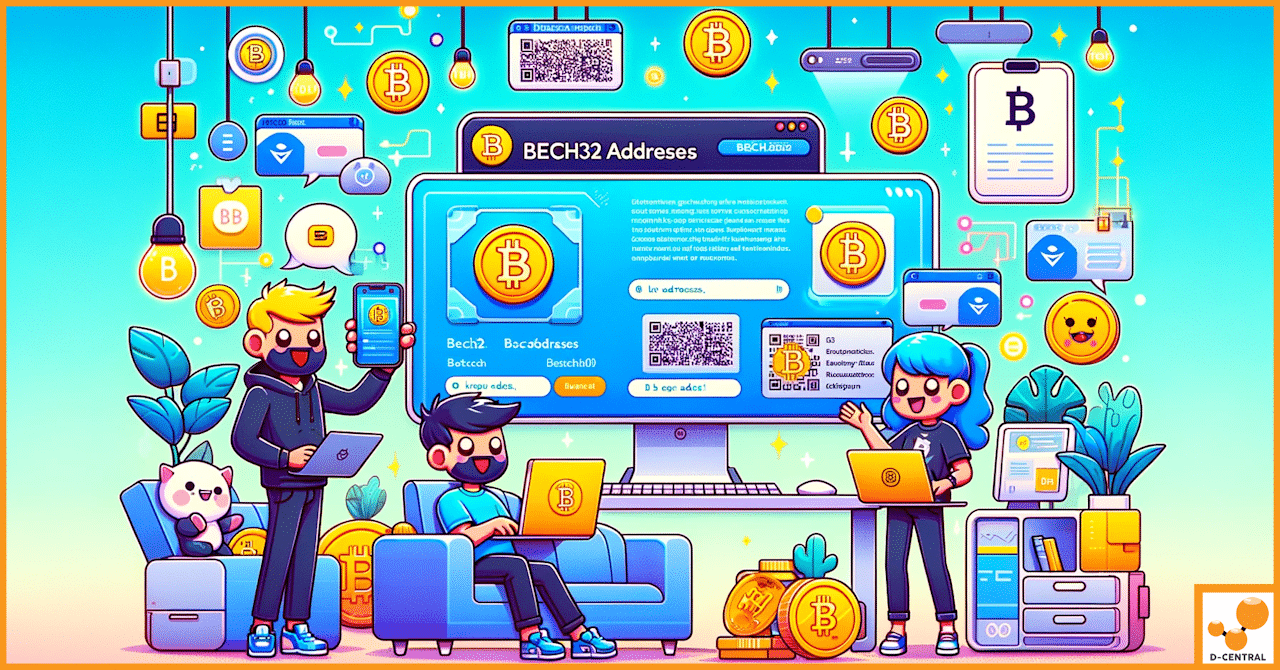
The Influence of Debt Capital Markets on Bitcoin Mining
In the realm of cryptocurrencies, Bitcoin mining holds a pivotal role. This process involves powerful computers performing complex calculations to
4479 Desserte Nord Autoroute 440, Laval, QC H7P 6E2

Since its inception, Bitcoin has undergone numerous enhancements, not just in its underlying technology but also in how transactions are conducted and recorded on the blockchain. One of the pivotal advancements in this journey has been the evolution of Bitcoin address formats. Initially, Bitcoin utilized the Pay-to-Public-Key-Hash (P2PKH) format, recognizable by addresses starting with ‘1’, and the Pay-to-Script-Hash (P2SH) format, with addresses beginning with ‘3’. These formats served the Bitcoin network well, facilitating the secure transfer of funds across the globe. However, as the network grew and scalability became a concern, the need for more efficient transaction processing methods became apparent.
Enter Segregated Witness (SegWit), a soft fork upgrade to the Bitcoin protocol introduced in 2017, which brought about a significant reduction in transaction size by separating the signature data (witness) from the transaction data. SegWit’s implementation paved the way for a new address format known as Bech32, which further optimized transaction processing on the Bitcoin network.
Bech32, specified by Bitcoin Improvement Proposals 173 (BIP 173) and later refined in BIP 350, represents a groundbreaking shift in Bitcoin address formats. Known for its distinctive prefix ‘bc1’, Bech32 addresses are not just a random string of characters but a carefully designed format that enhances the efficiency, security, and usability of Bitcoin transactions.
The significance of Bech32 in the cryptocurrency world cannot be overstated. It introduced several key improvements over its predecessors, including:
In essence, Bech32 addresses are not just an upgrade in format but a strategic enhancement to the Bitcoin protocol, aligning with the overarching goal of making Bitcoin more scalable, secure, and user-friendly. As the adoption of Bech32 addresses continues to grow, they mark a significant milestone in Bitcoin’s ongoing evolution, promising a more efficient and robust framework for the world’s leading cryptocurrency.
Bech32 is a Segregated Witness (SegWit) address format introduced to the Bitcoin network as part of its continuous evolution towards greater efficiency and security. Defined by Bitcoin Improvement Proposal 173 (BIP 173), Bech32 addresses are distinguished by their “bc1” prefix, followed by a lowercase alphanumeric string. This format is specifically designed for encoding native SegWit addresses, which significantly reduces the size of transactions by separating the witness (signature) data from the transaction data, thereby optimizing block space usage.
The technical foundation of Bech32 addresses lies in their unique encoding and error detection system. Bech32 employs a checksum mechanism that enhances the integrity of Bitcoin addresses by significantly reducing the risk of errors during address transcription and input. This is achieved through the use of a BCH (Bose–Chaudhuri–Hocquenghem) code, which provides strong error detection capabilities. Additionally, Bech32 addresses are case-insensitive, a feature that further minimizes the potential for errors and simplifies the user experience.
The journey from traditional Bitcoin addresses to Bech32 began with the network’s initial reliance on P2PKH and P2SH address formats. While these formats laid the groundwork for Bitcoin transactions, they were not without their limitations, particularly concerning efficiency and scalability. As the Bitcoin network grew, so did the demand for a more streamlined and cost-effective transaction process.
The introduction of Segregated Witness (SegWit) in 2017 marked a pivotal moment in Bitcoin’s history, addressing scalability issues by modifying how data was stored and transmitted within the blockchain. SegWit’s implementation necessitated a new address format that could fully leverage its benefits—thus, Bech32 was born. Bech32 addresses not only supported the segregation of signature data but also introduced improvements in error detection and user-friendliness, aligning with the broader goals of network optimization.
The development and adoption of Bech32 addresses were formalized through two key Bitcoin Improvement Proposals: BIP 0173 and BIP 0350. BIP 0173, introduced by Pieter Wuille and Greg Maxwell, outlined the initial framework for Bech32: a SegWit-compatible address format designed to enhance error detection and reduce transaction sizes. This proposal laid the foundation for Bech32’s integration into the Bitcoin protocol, setting the stage for a more efficient and secure transaction process.
Building on the groundwork laid by BIP 0173, BIP 0350 introduced Bech32m, a modified version of the original Bech32 format. This proposal, also spearheaded by Pieter Wuille, addressed a specific limitation in Bech32’s error detection capabilities when applied to future SegWit versions. Bech32m adjusted the checksum algorithm to ensure robust error detection across all SegWit versions, further solidifying the role of Bech32 addresses in facilitating secure and efficient Bitcoin transactions.
In summary, Bech32 represents a significant technological advancement in the Bitcoin ecosystem, offering a more efficient, secure, and user-friendly address format. The transition from traditional addresses to Bech32, guided by BIP 0173 and BIP 0350, reflects Bitcoin’s ongoing commitment to innovation and scalability, ensuring the network’s readiness for future growth and development.
Bech32 addresses represent a significant advancement in the Bitcoin ecosystem, introducing a range of features designed to enhance the efficiency, security, and usability of Bitcoin transactions. Below are the key features that set Bech32 addresses apart from their predecessors.
One of the most notable features of Bech32 addresses is their efficiency in block space usage. Bech32 addresses are native to Segregated Witness (SegWit), an upgrade that optimizes the size of transactions by separating the signature data (witness) from the transaction data. This separation allows for more transactions to be included in a single block, effectively increasing the network’s capacity without altering the block size limit. Bech32 addresses, by facilitating SegWit transactions, play a crucial role in enhancing the scalability of the Bitcoin network, leading to faster transaction processing times and lower fees for users.
Bech32 addresses incorporate a sophisticated error detection and correction system that significantly reduces the risk of errors when transcribing or inputting addresses. This system is based on a polynomial checksum algorithm that can detect up to four errors in an address and correct up to two errors, a feature not present in previous address formats. This robust error detection mechanism ensures a higher level of security for Bitcoin transactions, as it minimizes the chances of funds being sent to an incorrect address due to typographical errors.
The Bech32 address format exclusively uses lowercase letters, a design choice that has a profound impact on user experience. The absence of uppercase letters simplifies the process of reading, writing, and communicating addresses, reducing the likelihood of errors and confusion. This feature is particularly beneficial in scenarios where addresses need to be transcribed manually or communicated verbally. The uniformity of the lowercase format also enhances the legibility of addresses, making them more accessible to a broader range of users.
Bech32 addresses are intrinsically linked to Segregated Witness (SegWit), as they were specifically designed to support this protocol upgrade. SegWit addresses several issues associated with the Bitcoin network, including scalability, transaction malleability, and block size limitations. Bech32 addresses, by enabling SegWit transactions, contribute to the overall efficiency and security of the network. They allow for the creation of smaller transaction sizes, which in turn leads to lower transaction fees and faster processing times. Furthermore, the compatibility with SegWit opens the door for future technological advancements and enhancements within the Bitcoin protocol, ensuring that Bech32 addresses remain at the forefront of Bitcoin’s evolution.
Bech32 addresses bring forth a suite of features that address some of the longstanding challenges faced by the Bitcoin network. Their efficiency in block space usage, advanced error detection capabilities, user-friendly lowercase format, and compatibility with SegWit collectively contribute to a more secure, scalable, and accessible Bitcoin ecosystem.
Bech32 addresses represent a significant leap forward in the design and functionality of Bitcoin addresses. Their structure, generation process, and integrated error correction mechanism are meticulously engineered to enhance the security, efficiency, and user experience of Bitcoin transactions. Here, we delve into the technical intricacies that underpin Bech32 addresses.
A Bech32 address comprises three main components: a human-readable part (HRP), a separator, and a data payload. The HRP for Bitcoin addresses is “bc” for mainnet and “tb” for testnet, indicating the network for which the address is valid. This is followed by a separator, which is always “1”, serving as a clear demarcation between the HRP and the data payload.
The data payload is a base32-encoded string representing the witness version and the witness program. The witness version is a single digit that indicates the SegWit version, and the witness program is a hash that corresponds to the public key or script. This encoding uses a set of 32 characters, comprising the numbers 0-9 and lowercase letters excluding “1”, “b”, “i”, and “o” to avoid confusion in transcription.
The generation of a Bech32 address from a public key involves several cryptographic operations:
The checksum is a critical component of the Bech32 address format, providing a powerful error detection mechanism. It is calculated using a BCH code—a type of error-correcting code that can detect and correct errors in data transmission or storage. The Bech32 checksum is specifically designed to catch up to four errors in an address and can even identify the location of up to two errors, allowing for their correction.
This error detection capability is particularly important in the context of Bitcoin transactions, where a single mistake in an address can result in the loss of funds. By integrating a robust checksum, Bech32 addresses significantly reduce the risk of such errors, enhancing the overall security and reliability of Bitcoin transactions.
In summary, the technical design of Bech32 addresses—encompassing their structured format, generation process from public keys, and integrated checksum for error correction—represents a thoughtful and sophisticated approach to improving Bitcoin’s infrastructure. These technicalities ensure that Bech32 addresses are not only more efficient and secure but also more user-friendly, marking a significant advancement in the cryptocurrency space.
The introduction of Bech32 addresses has brought about significant improvements in the Bitcoin network’s functionality and user experience. These addresses, designed to fully leverage the benefits of the Segregated Witness (SegWit) protocol, offer several key advantages over traditional Bitcoin address formats. Here, we explore the primary benefits of adopting Bech32 addresses for Bitcoin transactions.
Bech32 addresses inherently enhance the security of Bitcoin transactions through their structure and the SegWit protocol they support. By separating the witness (signature) data from the transaction data, SegWit addresses a critical vulnerability known as transaction malleability. This separation means that the transaction ID cannot be altered by changing the signature data, a feature that directly contributes to a more secure and robust Bitcoin network. Furthermore, the checksum mechanism in Bech32 addresses significantly reduces the risk of errors in address transcription, minimizing the chances of funds being sent to incorrect addresses due to typographical errors.
One of the most immediate benefits of using Bech32 addresses is the reduction in transaction fees. SegWit transactions, which are enabled by Bech32 addresses, are smaller in size compared to their non-SegWit counterparts. This size reduction is achieved by removing signature data from the transaction data, thereby requiring less block space. Since transaction fees are calculated based on the size of the transaction in bytes, smaller transactions result in lower fees. This efficiency makes Bech32 addresses an economically advantageous choice for users looking to optimize their transaction costs on the Bitcoin network.
Bech32 addresses incorporate a sophisticated error detection and correction system that is a significant improvement over previous address formats. The checksum algorithm used in Bech32 addresses can detect up to four errors in an address and precisely identify the location of up to two errors, allowing for their correction. This level of error detection is unprecedented in Bitcoin address formats and greatly reduces the risk of loss of funds due to mistyped addresses. The use of a single case (lowercase) in Bech32 addresses further minimizes the potential for errors, enhancing the overall reliability of Bitcoin transactions.
Bech32 addresses are designed with future scalability and protocol upgrades in mind. The structure of Bech32 addresses, including the segregation of witness data, lays the groundwork for further innovations and optimizations within the Bitcoin network. As the Bitcoin protocol continues to evolve, Bech32 addresses are poised to support new features and enhancements seamlessly. This forward compatibility ensures that users adopting Bech32 addresses today are well-positioned to benefit from future developments in Bitcoin technology without the need for disruptive or complex transitions.
The adoption of Bech32 addresses offers a multitude of advantages, from enhanced security and reduced transaction fees to improved error detection and forward compatibility with future upgrades. These benefits collectively contribute to a more efficient, secure, and user-friendly Bitcoin network, underscoring the importance of Bech32 addresses in the ongoing evolution of cryptocurrency transactions.
The continuous evolution of the Bitcoin network has led to the development of Bech32m, a refined version of the Bech32 address format. This advancement addresses specific limitations of its predecessor, ensuring that the network remains adaptable and secure as it scales. Here, we delve into the introduction, purpose, and key distinctions of Bech32m, highlighting its role in the future of Bitcoin transactions.
Bech32m was introduced as a response to a discovery that the original Bech32 address format had limitations in its error detection capabilities, particularly concerning SegWit version 1 outputs and beyond. Recognized by Bitcoin Improvement Proposal 350 (BIP 350), Bech32m aims to rectify this by enhancing the checksum algorithm used in Bech32 addresses. This modification ensures that Bech32m addresses maintain robust error detection and correction features, crucial for the security and integrity of Bitcoin transactions.
While Bech32 and Bech32m addresses share a similar structure and purpose, the key difference lies in their checksum algorithms. Bech32m addresses use a modified checksum calculation to ensure that errors within any part of the address are reliably detected and corrected, a feature that becomes increasingly important with the introduction of new SegWit versions. Additionally, Bech32m addresses are specifically designed to support SegWit version 1 and higher, making them essential for the implementation of advanced features like Taproot.
The “m” in Bech32m stands for “modified,” signifying the enhanced error detection capabilities of this new address format. The modification to the checksum algorithm addresses a critical oversight in the original Bech32 format, where certain types of errors could go undetected in specific contexts. By improving the checksum mechanism, Bech32m ensures that the Bitcoin network can continue to offer a high degree of security and reliability as it adopts new technological advancements.
The introduction of Bech32m is closely tied to the adoption of Taproot, a significant upgrade to the Bitcoin protocol that enhances privacy, efficiency, and flexibility in Bitcoin transactions. Taproot introduces new types of transactions that require the improved error detection capabilities of Bech32m addresses. As such, Bech32m is not just an incremental improvement over Bech32 but a necessary evolution to accommodate the next generation of Bitcoin’s technological advancements. The adoption of Bech32m addresses by wallets, exchanges, and other services is crucial for the seamless integration of Taproot and future SegWit-based script upgrades, ensuring that the Bitcoin network remains at the forefront of cryptocurrency innovation.
In summary, Bech32m represents a critical step forward in the development of Bitcoin address formats. By addressing the limitations of Bech32 and ensuring compatibility with Taproot and future upgrades, Bech32m addresses pave the way for a more secure, efficient, and versatile Bitcoin network. The adoption of this new format is essential for harnessing the full potential of Bitcoin’s evolving technology, marking another milestone in the cryptocurrency’s ongoing journey towards widespread adoption and utility.
The adoption of Bech32 addresses by wallets and exchanges marks a significant milestone in the evolution of Bitcoin’s infrastructure, offering users enhanced efficiency, security, and lower transaction fees. This section explores the current state of Bech32 address support, the challenges and considerations for integration, and guidance for users on leveraging Bech32 addresses for their transactions.
Since the introduction of Bech32 addresses, there has been a gradual but steady increase in support across various cryptocurrency wallets and exchanges. Many leading platforms have recognized the benefits of Bech32 addresses, such as reduced transaction fees and improved error detection, and have integrated support for them. Users of these platforms can now generate Bech32 addresses for receiving and sending Bitcoin, enjoying the advantages that come with the SegWit protocol.
However, the adoption rate varies across the ecosystem, with some platforms yet to fully support Bech32 addresses. This inconsistency can lead to compatibility issues, where users may find themselves unable to send Bitcoin to a Bech32 address from a wallet or exchange that has not yet updated its system to support the new format.
Integrating Bech32 addresses into wallets and exchanges presents several challenges and considerations, including:
For users looking to take advantage of Bech32 addresses, the following steps can guide them in adopting this new format for their Bitcoin transactions:
The integration of Bech32 addresses into wallets and exchanges is a crucial step forward in optimizing Bitcoin’s efficiency and usability. While challenges remain in achieving universal support, the collective efforts of developers, platforms, and users will continue to drive the adoption of Bech32 addresses, ensuring that the Bitcoin network remains robust and scalable for the future.
The journey through the intricacies and advantages of Bech32 addresses underscores a pivotal evolution in the Bitcoin ecosystem. As we’ve explored, Bech32 addresses are not merely a new format but represent a significant leap towards making Bitcoin transactions more efficient, secure, and user-friendly. The introduction of Bech32, followed by the refinement of Bech32m, showcases the Bitcoin community’s commitment to continuous improvement and innovation.
Bech32 addresses bring a host of benefits to the Bitcoin network, including enhanced block space efficiency, improved error detection and correction capabilities, and a user-friendly lowercase format. These features collectively contribute to reducing transaction fees, minimizing the risk of errors, and ensuring a smoother user experience. Moreover, the compatibility of Bech32 addresses with SegWit and future protocol upgrades positions the Bitcoin network for sustainable growth and scalability.
The adoption of Bech32 addresses marks a significant milestone in the ongoing development of the Bitcoin protocol. As the ecosystem continues to evolve, the forward compatibility of Bech32 addresses ensures they will remain a cornerstone of Bitcoin’s infrastructure, supporting new features and enhancements. The future of Bitcoin transactions, with Bech32 addresses at the forefront, promises greater efficiency, security, and accessibility, paving the way for broader adoption of cryptocurrency.
The widespread adoption of Bech32 addresses is crucial for realizing their full potential in enhancing the Bitcoin network. Users are encouraged to adopt Bech32 addresses for their transactions, taking advantage of the benefits they offer. Similarly, service providers, including wallets and exchanges, play a vital role in supporting Bech32 addresses, facilitating their use, and educating their customers about their advantages.
We invite all members of the Bitcoin community to explore and adopt Bech32 addresses for their transactions. Whether you’re a seasoned Bitcoin user or new to the cryptocurrency world, Bech32 addresses offer a more efficient and secure way to manage your transactions. By choosing wallets and platforms that support Bech32 addresses, you contribute to the advancement of the Bitcoin network and enjoy the benefits of this innovative technology.
DISCLAIMER: D-Central Technologies and its associated content, including this blog, do not serve as financial advisors or official investment advisors. The insights and opinions shared here or by any guests featured in our content are provided purely for informational and educational purposes. Such communications should not be interpreted as financial, investment, legal, tax, or any form of specific advice. We are committed to advancing the knowledge and understanding of Bitcoin and its potential impact on society. However, we urge our community to proceed with caution and informed judgment in all related endeavors.
Related Posts

In the realm of cryptocurrencies, Bitcoin mining holds a pivotal role. This process involves powerful computers performing complex calculations to

In the rapidly evolving world of cryptocurrency, Bitdeer has emerged as a prominent player in the mining community. Headquartered in

In the ever-evolving world of cryptocurrency mining, having the right power supply unit (PSU) is crucial for optimizing performance and